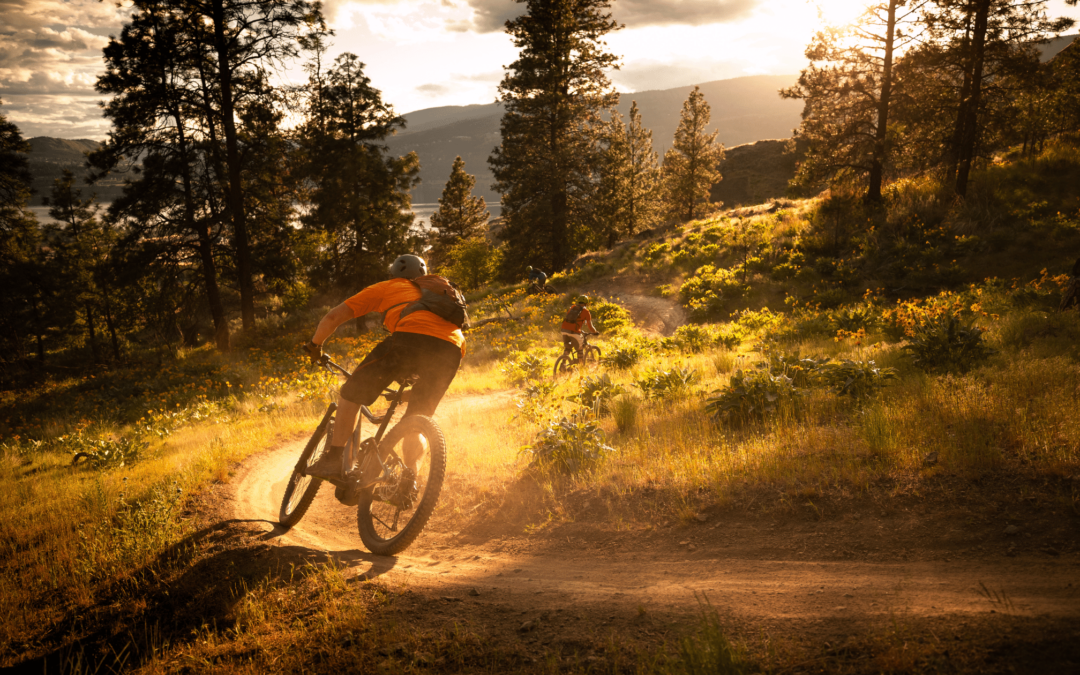The beauty of living in Central Oregon is our year-round recreational opportunities and the effortless flow from one seasonal activity to the next. One favorite is biking – both mountain and road. Even though we are well into biking season, and some are considering when to get their skis tuned and waxed, getting your body prepared for cycling is crucial. Doing so can go a long way toward ensuring the rest of your season is comfortable and injury-free and will even help with the sports you want to enjoy when ski season rolls around.
One of the very best ways to get your body prepared for biking and injury-free is with stretching.
Why is flexibility important to cyclists?
Flexibility is important for two reasons. First, cycling is a series of repetitive motions that use specific muscles in one plane of motion. Dynamic motion, on the other hand, uses muscles in varied directions of motion.
Are you still with us?
When muscles are worked to fatigue, they tighten and contract during their recovery phase. This results in a gradual loss of flexibility in the opposite motion over time.
The second reason to address flexibility comes down to the position of the upper body during cycling. For our legs to gain stability to do the repetitive work required of road/mountain biking, cyclists tend to flex (bend) through the spine and upper trunk. They hold this position over an extended period, which leads to a loss of motion in the opposite positions. So, now armed with that insight, we get to the goods.
Since we too ride, we’ve dialed it into a few ‘bang for buck’ stretches to keep it quick and easy to perform with a few alternative positions to meet your particular needs.
Hip Flexors
Your hip flexors are a powerful group of two muscles – the psoas and the iliacus. The psoas attaches off the anterior lumbar spine to the femur (your upper thigh bone), and the iliacus attach off the anterior pelvis and joins the psoas. The “iliopsoas” is the muscle that brings your thigh up from the downstroke position of pedaling.
To stretch: start in a 1/2 kneel position with an upright trunk. You will be stretching the anterior thigh of the leg in which you are kneeling. With your front leg bent in a 90/90 position, extend your rear knee behind you, keeping your pelvis/spine from twisting back. From this position, transition your body toward the front leg while elongating at the front thigh of the rear leg. Your trunk should stay in a midline upright position. As you bend your front knee, your body should slightly move closer towards the ground. You should feel the stretch in your front thigh, not your back. Hold 30-60 seconds with three reps.

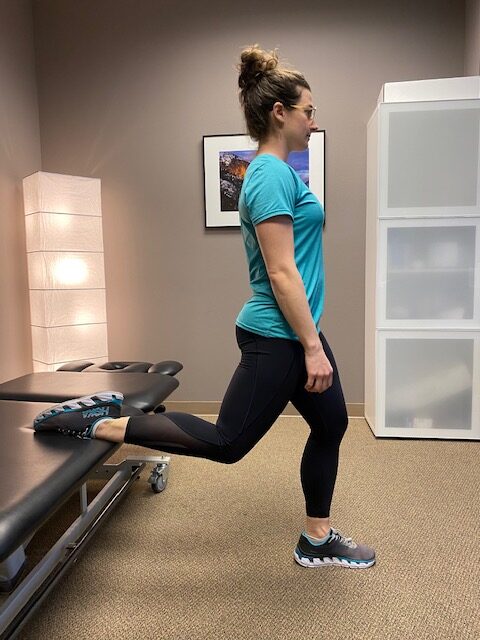
Hamstrings
The hamstrings are muscles under that repetitive linear group of motion used both in the down and upstroke of pedaling. Your hamstrings consist of a group of three muscles that attach from the ‘sit bones’ of your pelvis to behind your knee at the tibia (shin bone).
To stretch: Start by lying in a door frame. Place one leg on the wall with your knee slightly bent. Scoot your body closer to the door frame keeping your trunk/pelvis flat on the ground while your opposite leg lies ‘through’ the frame. Due to the passive nature of this stretch, a long-duration stretch here is easy to perform. Hold for 1-3 minutes (or longer if you’d like) with 1-3 reps. Then repeat on your opposite leg.
An alternative is to perform this stretch using a yoga strap. Keep a slight bend in your knee to start.
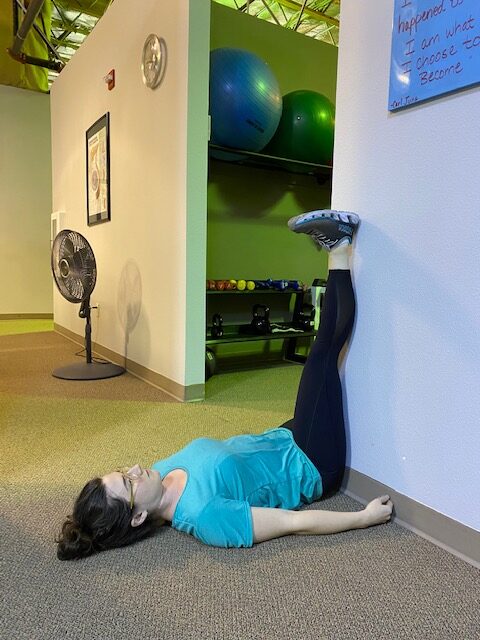

Thoracic Extension
Spinal flexibility (or lack thereof) is a big reason why you may be experiencing neck pain by the end of your ride. Most often, the lack of thoracic extension (think backbend) is the underlying culprit. This comes from a sustained forward position while cycling. The foam roll comes in handy here.
To stretch: Start lying with the foam roll positioned across your spine from left to right. Place the foam roller just above the ‘apex’ of your mid-back curve. Typically this is behind your chest, but you can adjust to find the point that works well for you. Place your hands behind your neck to support your head and comfortably rest your pelvis on the ground with your knees bent/feet flat. The goal here is to stretch the thoracic spine (not your neck), so we want to hold the neck in a mid-line or slightly extended position as we lean over the roll to your end range. Keep your pelvis on the ground and work to isolate your mid-back. Often, the lower back will arch before the thoracic spine. Be aware of this if you do not at first feel a restriction of movement. You can move the roller slightly up or down to find your point of restriction. Perform 10-15 reps with a 5-second hold or a sustained hold of 60 secs for 1-3 times, depending on your preference

If you do not own a foam roller, the cat/cow yoga stretch is a great alternative that activates the lumbar (lower back) spine. Focus on the thoracic spine extending in the cow position versus the neck doing all of the motion. This takes body awareness, but in time you will get it. Focus on comfortably working into your end range. Perform 10-20 reps with a 5-second hold.


Doorway Stretch
The doorway stretch addresses the pectoral (anterior chest) musculature of the upper trunk. This is another muscle that may tighten due to the extended position of the upper trunk.
To stretch: In a doorway, place your hands in a 90/90 position and step through the doorway (versus leaning). Keep your chest upright to the point of restriction. You should feel the stretch across the anterior chest/shoulders. If you get shoulder pain, you may need to perform one arm at a time and add a slight rotation away from the arm you are stretching. Hold for 30-60 seconds and repeat 3 times.
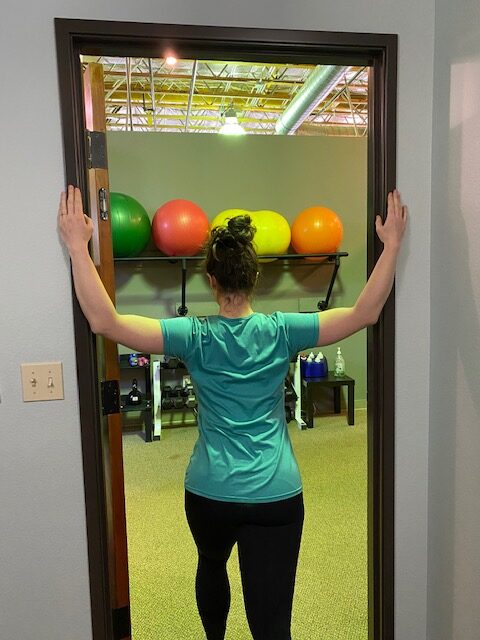
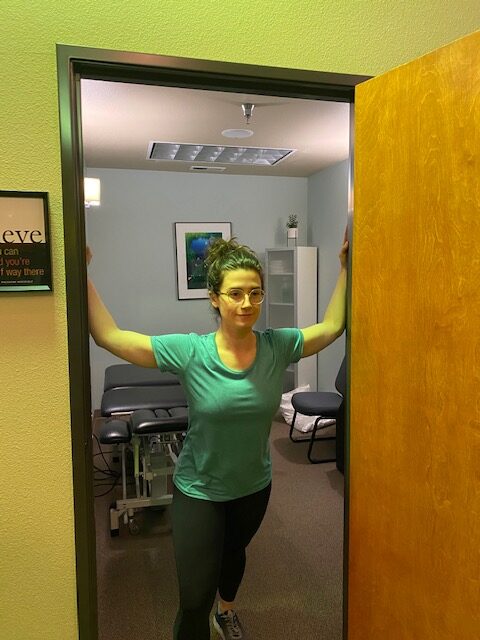
Need to stretch on the fly at the trailhead? Try this: Place both arms behind your with fingers grasped at waist level. Keeping your chest upright, extend your arms away from your body to feel stretch across your chest/shoulders.
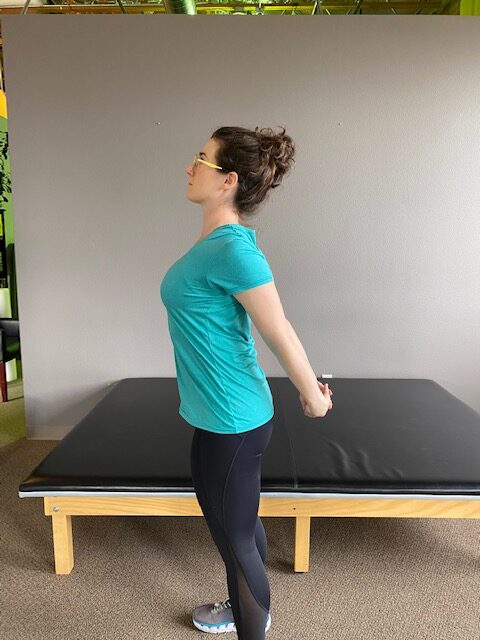
Wrist/Hand Flexors

Extended gripping can lead to tightness in your hands.
To stretch: Hold one arm out in front of you and grab with the opposite hand at your palm and fingers of the arm extended. Keeping your elbow extended, pull your hand down to your end range, then twist, so the forearm rotates to position the fingers ‘in.’ In the arm being stretched, this rotation is clockwise on the right arm and counter-clockwise on the left. This rotation helps to get a deeper/global stretch. Hold for 30-60 seconds and repeat three times.
In Summary…
When implementing these stretches, trust your body and what works for you. Some people respond better to stretching before riding, some afterward. Stretching should also be comfortable. If you find that a particular stretch is consistently painful, it may signify an underlying condition that needs to be addressed. We have found that the best thing that you can do is warm up and ease into your ride. Doing so makes the ride more enjoyable and increases your chances of staying injury-free.
At Alpine PT, we are proud to serve the Central Oregon community in orthopedic and sports-related rehabilitation. Like you, we live to get out and recreate so we can experience every day!
For more information, call 541-382.5500 or email us at info@alpinephysicaltherapy.com
